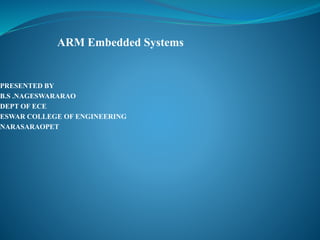Unit vi (1)
•Download as PPTX, PDF•
2 likes•3,386 views
FOR III BTECH STUDENTS
Report
Share
Report
Share

Recommended
Recommended
More Related Content
What's hot
What's hot (20)
Similar to Unit vi (1)
Similar to Unit vi (1) (20)
How to Select Hardware for Internet of Things Systems?

How to Select Hardware for Internet of Things Systems?
Embedded Systems (18EC62) - ARM - 32-Bit Microcontroller (Module 1)

Embedded Systems (18EC62) - ARM - 32-Bit Microcontroller (Module 1)
More from Siva Nageswararao
More from Siva Nageswararao (6)
Recently uploaded
Process of Integration the Laser Scan Data into FEA Model and Level 3 Fitness-for-Service Assessment of Critical Assets in Refinery & Process IndustriesFEA Based Level 3 Assessment of Deformed Tanks with Fluid Induced Loads

FEA Based Level 3 Assessment of Deformed Tanks with Fluid Induced LoadsArindam Chakraborty, Ph.D., P.E. (CA, TX)
Recently uploaded (20)
Block diagram reduction techniques in control systems.ppt

Block diagram reduction techniques in control systems.ppt
FEA Based Level 3 Assessment of Deformed Tanks with Fluid Induced Loads

FEA Based Level 3 Assessment of Deformed Tanks with Fluid Induced Loads
A CASE STUDY ON CERAMIC INDUSTRY OF BANGLADESH.pptx

A CASE STUDY ON CERAMIC INDUSTRY OF BANGLADESH.pptx
Learn the concepts of Thermodynamics on Magic Marks

Learn the concepts of Thermodynamics on Magic Marks
S1S2 B.Arch MGU - HOA1&2 Module 3 -Temple Architecture of Kerala.pptx

S1S2 B.Arch MGU - HOA1&2 Module 3 -Temple Architecture of Kerala.pptx
DC MACHINE-Motoring and generation, Armature circuit equation

DC MACHINE-Motoring and generation, Armature circuit equation
Tamil Call Girls Bhayandar WhatsApp +91-9930687706, Best Service

Tamil Call Girls Bhayandar WhatsApp +91-9930687706, Best Service
Bhubaneswar🌹Call Girls Bhubaneswar ❤Komal 9777949614 💟 Full Trusted CALL GIRL...

Bhubaneswar🌹Call Girls Bhubaneswar ❤Komal 9777949614 💟 Full Trusted CALL GIRL...
Hazard Identification (HAZID) vs. Hazard and Operability (HAZOP): A Comparati...

Hazard Identification (HAZID) vs. Hazard and Operability (HAZOP): A Comparati...
Unit vi (1)
- 1. ARM Embedded Systems PRESENTED BY B.S .NAGESWARARAO DEPT OF ECE ESWAR COLLEGE OF ENGINEERING NARASARAOPET
- 2. Outline: What is ARM Processor The RISC design philosophy The ARM Design Philosophy Instruction Set for Embedded Systems Embedded System Hardware ARM Bus Technology AMBA Bus Protocol Memory Peripherals Embedded System Software Initialization (Boot) Code Memory mapping Operating System Applications
- 3. what is ARM Processor: An ARM processor is one of a family of CPUs based on the RISC (reduced instruction set computer) architecture developed by Advanced RISC Machines(ARM). ARM makes 32-bit and 64-bit RISC multi-core processors
- 4. The RISC design philosophy The RISC philosophy is implemented with four major design rules: 1) instructions, 2) Pipelines, 3) Registers, 4) Load-store architecture
- 5. The ARM Design Philosophy There are a number of physical features that have driven the ARM processor design, First, portable embedded systems require some form of battery power. High code density is another major requirement since embedded systems have limited memory due to cost and/or physical size restrictions. Another important requirement is to reduce the area of the die taken up by the embedded processor.
- 6. Instruction Set for Embedded Systems The ARM instruction set differs from the pure RISC definition in several ways that make the ARM instruction set suitable for embedded applications: *Variable cycle execution for certain instructions *Inline barrel shifter leading to more complex instructions *Thumb 16-bit instruction set *Conditional execution *Enhanced instructions
- 7. Embedded System Hardware An example of an ARM-based embedded device, a microcontroller.
- 8. ARM Bus Technology Embedded systems use different bus technologies than those designed for x86 PCs. The most common PC bus technology, the Peripheral Component Interconnect (PCI) bus, connects such devices as video cards and hard disk controllers to the x86 processor bus. A bus has two architecture levels. Physical level Protocol- the logical
- 9. AMBA Bus Protocol: The Advanced Microcontroller Bus Architecture (AMBA) was introduced in 1996. ARM System Bus (ASB) ARM Peripheral Bus(APB) ARM High Performance Bus (AHB) ARM has introduced two variations on the AHB bus: Multi-layer AHB and AHB-Lite.
- 10. Memory: An embedded system has to have some form of memory to store and execute code. Width: The memory width is the number of bits the memory returns on each access typically8, 16, 32, or 64 bits. The memory width has a direct effect on the overall performance and cost ratio. Fetching instructions from memory. Types: ROM DRAM SRAM SDRAM Instruction size 8-bit memory 16-bit memory 32-bit memory ARM 32-bit 4 cycles 2 cycles 1 cycle Thumb 16- bit 2 cycles 1 cycle 1 cycle
- 11. Peripherals Embedded systems that interact with the outside world need some form of peripheral device A peripheral device performs input and output functions for the chip by connecting to other devices or sensors that are off-chip. Two important types of controllers are memory controllers and interrupt controllers. Memory Controllers Interrupt Controllers
- 12. Embedded System Software An embedded system needs four typical software components required to control an embedded device. Each software component in the stack uses a higher level of abstraction to separate the code from the hardware device. Hardware device Initialization Device drivers Operating system Application Software abstraction layers executing on hardware.
- 13. Memory mapping
- 14. Operating System ARM processors support over 50 operating systems. We can divide operating systems into two main categories: real-time operating systems (RTOSs) and platform operating systems. RTOSs provide guaranteed response times to events. Different operating systems have different amounts of control over the system response time. Platform operating systems require a memory management unit to manage large, non real- time applications and tend to have secondary storage.
- 15. Applications ARM processors are found in numerous market segments, including networking, automotive, mobile and consumer devices, mass storage, and imaging. Within each segment ARM processors can be found in multiple applications. For example, the ARM processor is found in networking applications like home gateways, DSL modems for high- speed Internet communication, and 802.11 wireless communication. The mobile device segment is the largest application area for ARM processors because of mobile phones.
